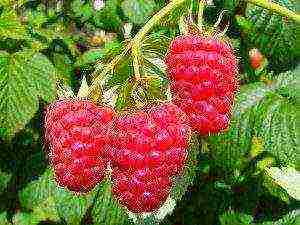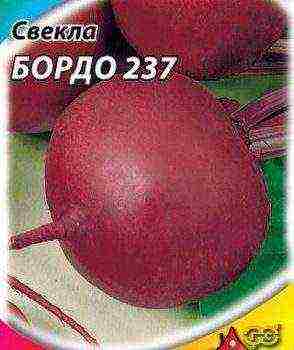Content

Zucchini is a close relative of pumpkin, they will differ in terms of ripening and taste. Most of the preparations for the winter are made from this vegetable; during the season, there will be some kind of dish from it on the table almost every day. Let's look at a description of its popular varieties.
Content:
Description
Zucchini are very useful for humans, they contain:
- many vitamins and minerals that have a positive effect on the general condition of the body
- fiber, which helps to normalize digestion and cleansing functions of the body
- a small amount of calories, which allows the use of the product in a diet to normalize weight

Variety of zucchini
Excellent taste and variety in preparation make zucchini just a favorite dish for many consumers during their fruiting period.
back to menu ↑ How to choose 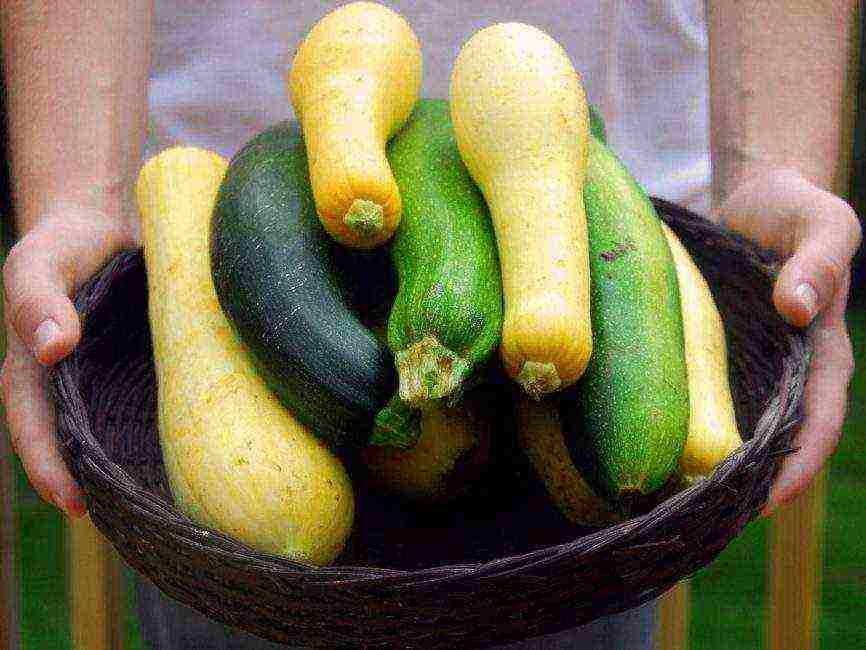
You can choose zucchini for yourself to taste and even color
In order to get the maximum possible yield of zucchini, it is important to choose the right variety, while taking into account personal preferences in color.
It is also worth taking into account the following points:
Some gardeners are trying to artificially extend the fruiting period of zucchini. But in many cases, this does not justify the hopes imposed, the fruits in such cases are of less value in terms of taste and the content of useful substances in them.
Particular attention is paid to the ripening period, it depends on them how soon you can prepare delicious dishes from zucchini for yourself and your loved ones.
According to early maturity, three types of vegetables are distinguished:
- early maturing
- mid-season
- late maturing
Given their ripening time for zucchini lovers, an almost uninterrupted supply of this vegetable can be ensured. Experienced gardeners often plant at least 3-5 species with different periods of fruiting, this is how the consumption of zucchini continues from early spring to late autumn, while greenhouses and greenhouses are often used.
In addition, in seed shops, sellers will offer several options for seed. Most of all, the hybrids of foreign breeders are appreciated, a huge selection will not allow you to decide right away.

Zucchini bush
Domestic varieties have fewer representatives, but even among them it is difficult to give preference to any one. Given the high competition in this market segment, it is better to prepare in advance and independently study some of them, make a list of the most suitable for you.
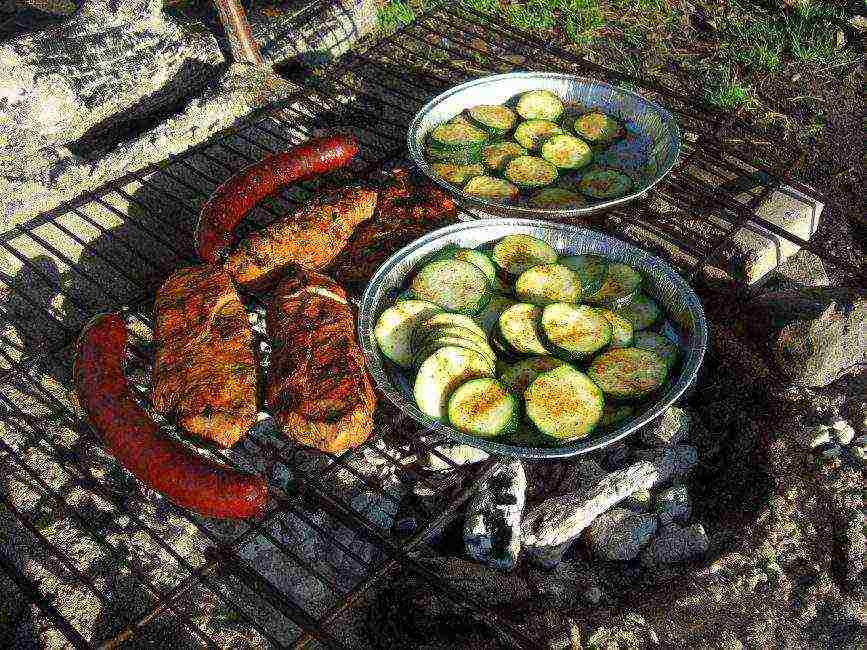
Grilled zucchini
According to the reviews of gardeners, it turned out to compile a small list of all the proposed ones, which are most common in our country. It is these varieties and species that are preferred by amateur gardeners and farmers for whom the harvest is important.
When making a selection, the taste of each variety was also taken into account, the description will explain how to grow properly and how to use ripe fruits in order to get the most out of the vegetable.
back to menu ↑ Bush varieties
Recently, these varieties of zucchini are in great demand, this is due to the fact that they take up little space, and sometimes even more fruiting than other representatives. They are not picky, easy to care for, and foreign hybrids have a relatively long storage period.
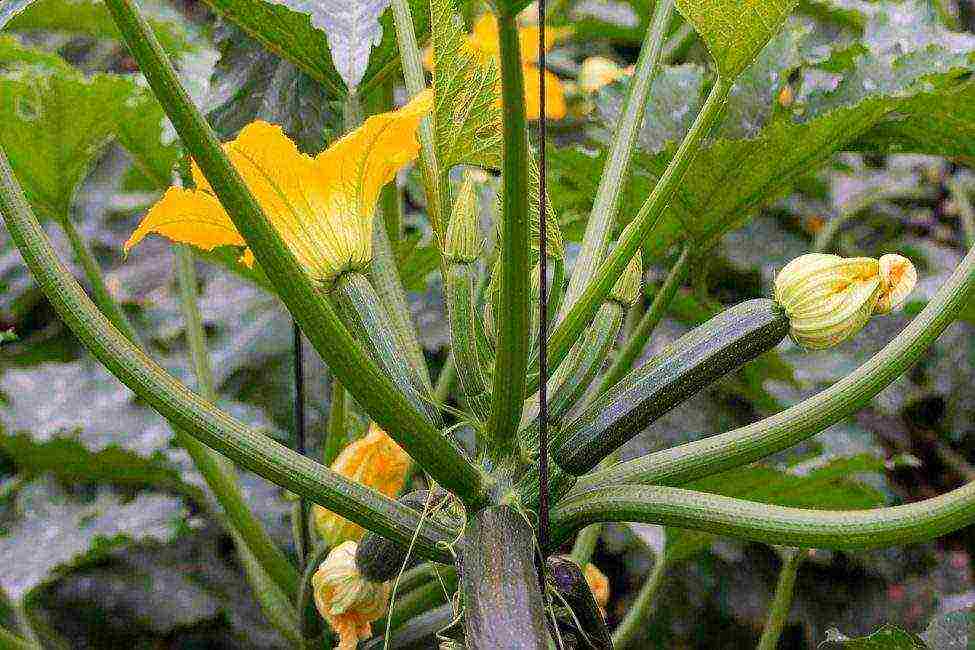
Zucchini bush
There are fruits with and without seeds. It largely depends on this how long the zucchini will not age during the preservation process and will be suitable for consumption.
back to menu ↑ Aeronaut 
Aeronaut
back to menu ↑ Astronomer 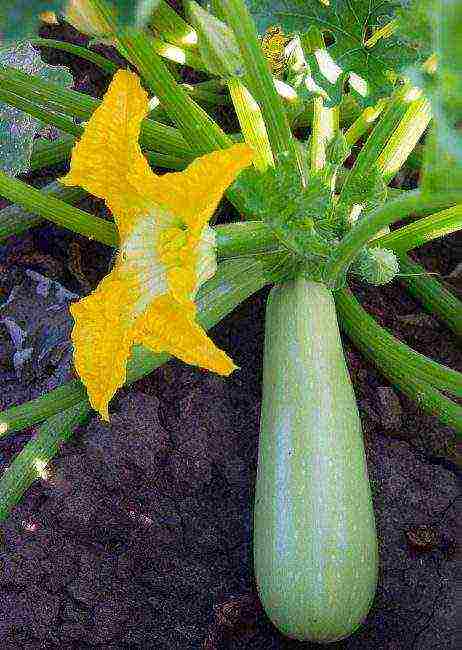
Astronomer
back to menu ↑ Black handsome
Black handsome
back to menu ↑ Tsukesha
Tsukesha
back to menu ↑ Yellow varieties 
One of the representatives of yellow zucchini
In a special way, gardeners refer to yellow zucchini, they will look like summer in a jar, and caviar from them has a more natural color, and a piece of the sun will be added to dishes prepared from fresh vegetables.
back to menu ↑ Pineapple 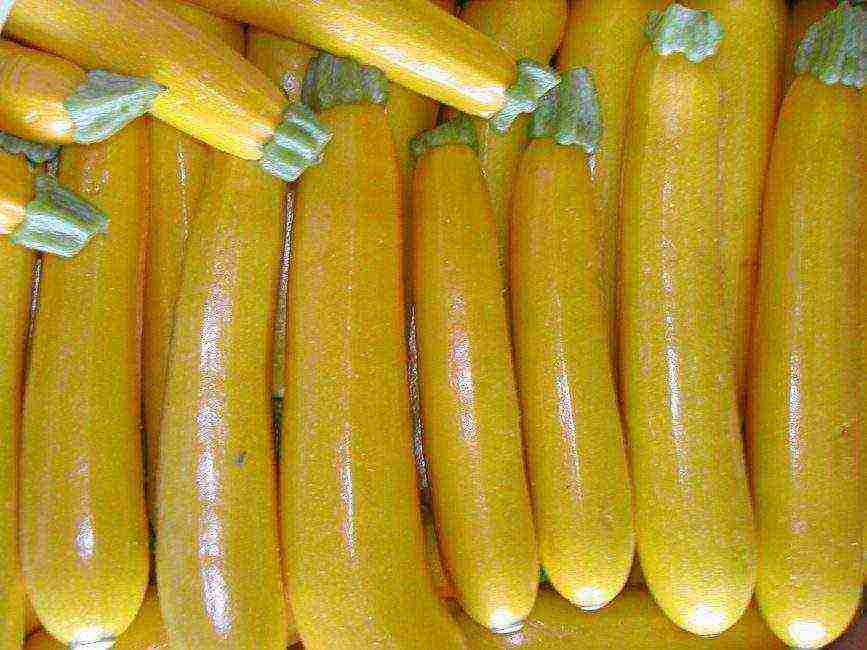
Pineapple
back to menu ↑ Zolotinka 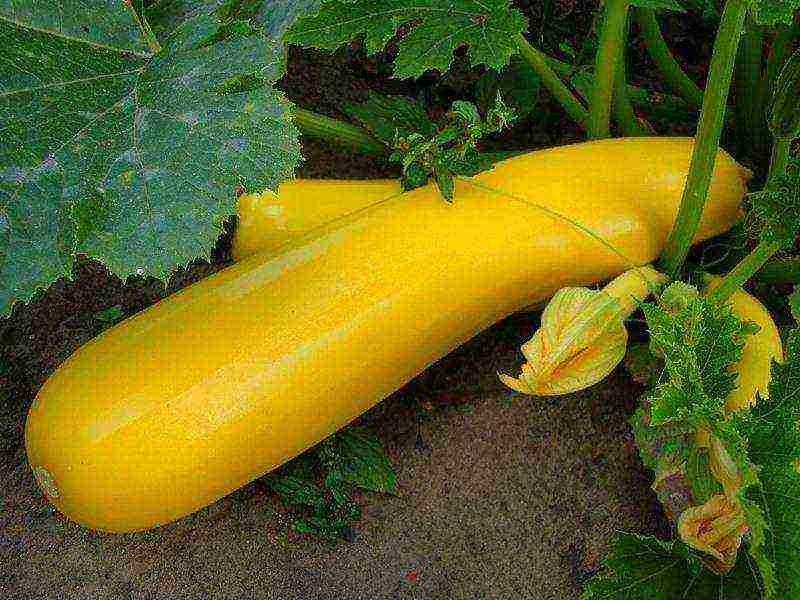
Zolotinka
Our gardeners also grow other varieties of yellow zucchini, but they are less popular or are common in only one region.
To prepare caviar from zucchini, you can combine the vegetables used, take 80% of yellow zucchini, add the rest white.
back to menu ↑ Early maturing varieties
Each gardener strives to get the result of his work as early as possible, looking forward to the fruits on the crops he has planted. To significantly save time and get a harvest faster, plant early ripening varieties of zucchini on your site

Zucchini vertical bed
Their general characteristics are as follows:
- the first fruits are harvested 40-45 days after germination
- plants tolerate temperature fluctuations
- they are not afraid of small frosts
Most often they are sown directly into the ground, sometimes sowing is done under a film.
back to menu ↑ Iskander 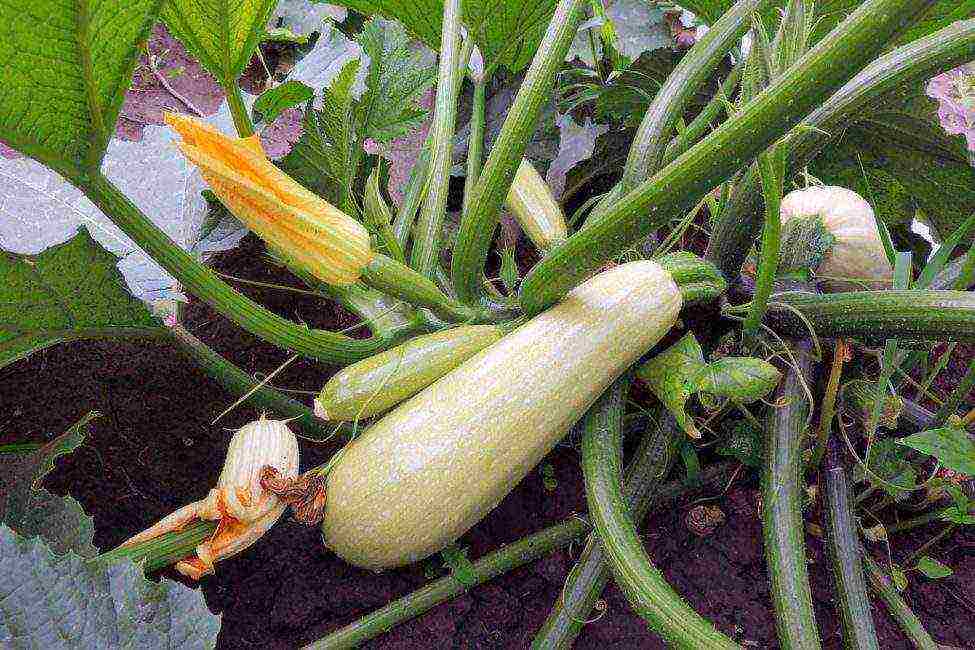
Iskander
back to menu ↑ Kavili 
Kavili
back to menu ↑ Gribovsky 
Gribovsky
back to menu ↑ Aral 
Aral
back to menu ↑ Movie 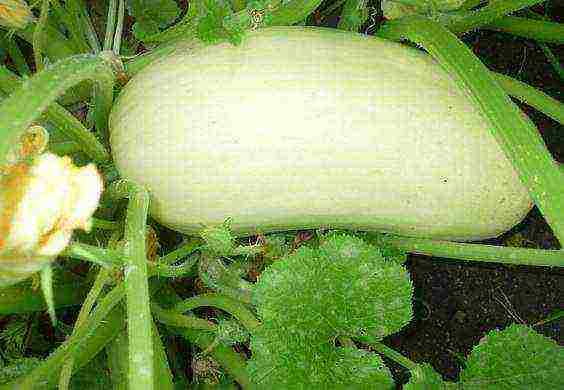
Video clip
back to menu ↑ Candela 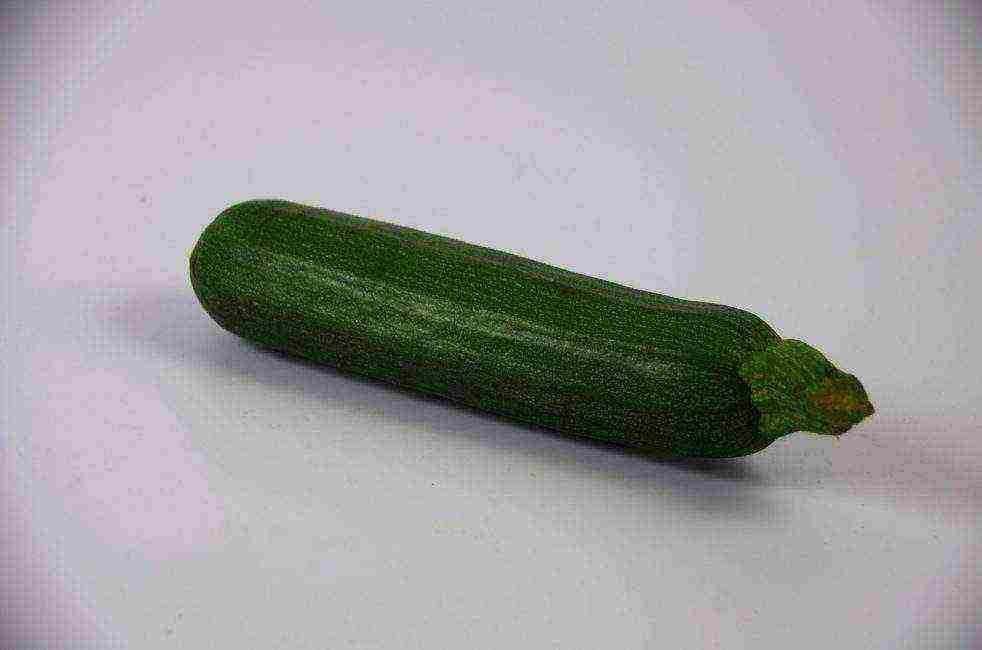
Candela
back to menu ↑ Anchor 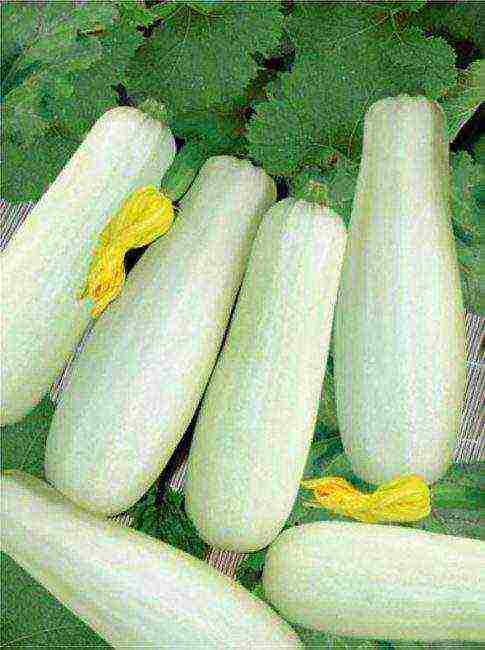
Anchor
back to menu ↑ Zebra
zebra
back to menu ↑ Diamant 
Diamond
back to menu ↑ Erema 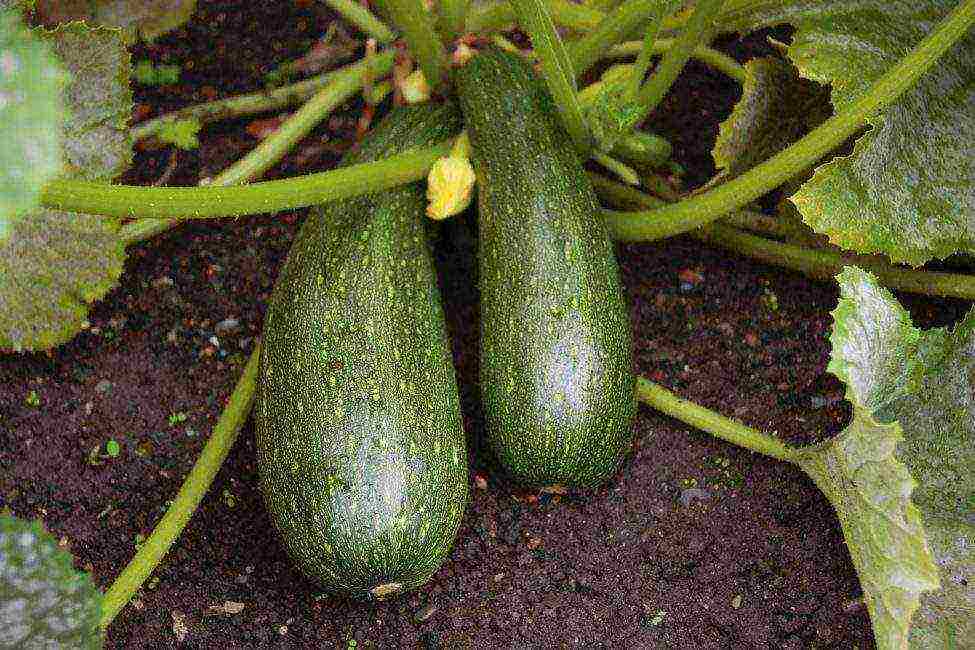
Erema
back to menu ↑ Souvenir 
Souvenir
back to menu ↑ Egyptian power 
Egyptian force
Early maturing varieties are cultivated in the same way as the rest, the only difference is that it is possible to sow seeds in open ground much earlier. A film covering will help speed up the shoots, which is simply removed over time. All gardeners are engaged in the cultivation of zucchini, many know about their useful properties, after all, such fruits are recommended for food even for diabetics.
The low calorie content of the product, even after heat treatment, makes it possible to use zucchini in the diet of people with overweight problems. Vitamins and minerals, and especially iodine, will be useful for everyone.
Harvesting zucchini in different ways for the winter allows you to please yourself in the cold season with a piece of summer.
8.8 Overall Score
Your opinion is very important to us. If you disagree with these ratings, leave your rating in the comments with the reasoning for your choice. Thank you for your participation. Your opinion will be useful to other users.
Relevance of information
Availability of application
8.5
Reliability of information
9.5
Add your review
It is customary to rank yellow zucchini among the herbaceous crops of the Pumpkin species, the Pumpkin family. We can say that it is one of the variants of the common pumpkin. Such a vegetable culture, on the one hand, looks great against the background of greenish leaves, and on the other hand, it possesses the wonderful taste of zucchini, which is why they are used everywhere in cooking (fried, stewed, baked) and in various types of preparations. So what are they, yellow zucchini? We learn the variety, calorie content and their other characteristics from this article.
What varieties of yellow zucchini are consumed fresh

About the yellow-fruited zucchini, we can say that it is not so widely in demand in the cuisines of the world than the zucchini, which are widespread almost everywhere. And yet, they can often be found in various parts of Russia.The general characteristics are almost the same, and their description is as follows: yellow zucchini has a much more fibrous structure than others, the structure of ripe pulp, moreover, it is immediately clear that its skin is colored in a rather peculiar way.
Gardeners and buyers give these zucchini preference over other types due to the fact that they look pretty outwardly, their calorie content is low (there are only seventeen kcal per 100 g of pulp).
Important!
these zucchini have excellent recommendations, because they are great both for feeding babies and for diet food.

It should be noted that yellow zucchini have some varieties, but all of them have a wonderful taste - their flesh is sweetish, rather juicy. Taking into account such taste qualities, zucchini is allowed, but even recommended to be consumed raw, because this is how it will be much healthier, and the human body will perceive such food better.
Today, such zucchini are no longer considered some kind of exotic. Each summer resident can cultivate them on his land plot or garden. It should be noted that gardeners and vegetable growers prefer several of the most successful species.
Gold Rush F1
The fruits are golden-yellow in color, the length of the zucchini is about twenty centimeters, and the weight reaches 210 g; the flesh is rather tender, creamy white in color. The advantages include the fact that this Dutch hybrid can be consumed both fresh and canned. By the terms of ripening and yield, we can say that it is early maturing, and the yield is about 11.5 kilograms per square meter.
Goldline F1
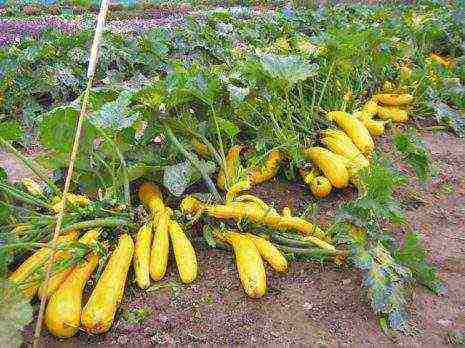
The fruits of this type of zucchini have a golden yellow color, they grow up to twenty to thirty centimeters, smooth on the surface, cylindrical in shape. The flesh of these vegetables is very sweet and juicy. The features include a good yield. These fruits differ from others in their high carotene content. Experts recommend choosing predecessors for them from onions, potatoes, cabbage or legumes.
Sunlight F1
The fruits of these zucchini are golden yellow in color, their length does not exceed eighteen centimeters, and the diameter is only four to five. Their flesh is dense and white. You can eat them both fresh and processed. As for the yield and ripening, this is a French hybrid form, it ripens early, and its yield is quite high.
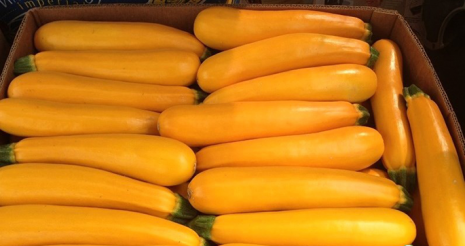
High-yielding yellow varieties
It is safe to say that it is the yellow-fruited zucchini that becomes the true pride of every gardener and the decoration of the land. Its fruits, which have shades from light yellow to bright orange, look very original, moreover, they have a great taste, and the flesh is mostly yellowish or yellow in color. The shapes and sizes are different for the varieties, which often surprises gardeners with considerable experience. Growing such vegetables is no more difficult than their green counterparts. Due to their indisputable advantages, both external and gustatory, and taking into account the ease of care, such fruits are gaining significant popularity from year to year.
Yellow-fruited zucchini is an excellent choice for canning. The taste is neutral, which is why such fruits are suitable for pickles, and for compotes, and even jam. In order to make preparations for the winter, it is more correct to pay attention to high-yielding varieties, because it is they who collect quite a decent amount of vegetables on a tiny square of soil.
Variety "Russian size"
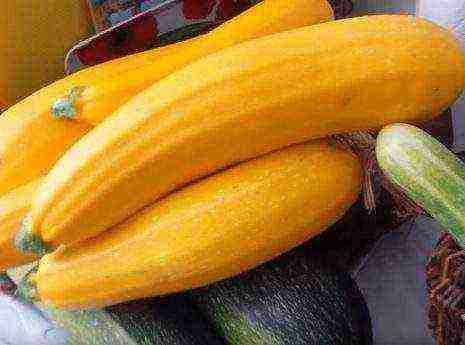
This variety is considered Hercules among the rest of the squash. Even farmers and gardeners with extensive experience are surprised at such a significant size - it grows up to one meter in length, and on average weighs about thirty kilograms. With these data, it is difficult to predict the overall yield of vegetables.
In order for the zucchini to mature, a period of time of about one hundred days is required after the seeds are sown.For these zucchini special conditions are not required: seedlings are grown in the last days of April. But they are transferred to the ground when there is constant good weather, when there is no longer frost at night. These vegetables need a gardener to water and feed them constantly.
Zucchini of this variety has a beautiful orange-pink pulp, it is quite tender, not containing coarse fibers. These fruits are used for conservation and for preparing various culinary dishes.
Important!
Orange zucchini can be stored for a long time in winter.
Variety "Anchor"

This variety is considered an early maturing variety. In order for these vegetables to ripen, fifty days will be enough from the time the seeds are immersed in the open ground. Such zucchini are quite resistant to both dry weather and cold weather. Thanks to this, despite the weather conditions, it is possible to get up to fifteen kilograms of harvest from just one square meter.
Seeds are usually sown in May and harvested before September. Experienced gardeners advise planting four plants per square meter.
You may be interested in:
Zucchini of this variety are yellow, rather large (weight over nine hundred grams), the shape resembles a cylinder, their peel is thin, the surface is smooth. A distinctive feature of this variety is the significant content of dry matter in the pulp of the fruit.
Zucchini zucchini "Zolotinka"
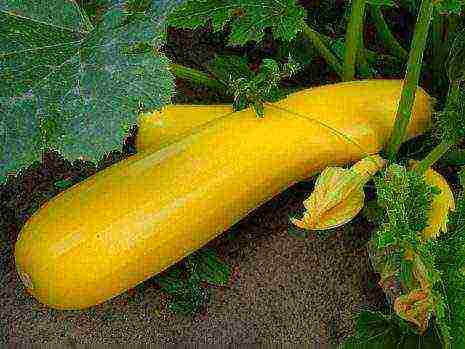
This variety has been grown in Russia for almost four decades. It is one of the first varieties of yellow zucchini bred. Its obvious advantages include high yield, and the fruits do not lose their taste for a very long time.
It is a bushy and compact plant. About fifteen bright fruits are usually harvested from one bush. Since this is an early ripening variety, harvesting begins after about 47-50 days from the day of planting.
Zucchini reach a length of fifteen centimeters, the fruit weighs about half a kilogram. The vegetables are smooth and firm. Small fruits are usually used for canning. Due to its density and the fact that the pulp is juicy, it is similar to a cucumber, crisp and sweet.
This variety of zucchini is perfect for feeding babies from one to seven years old. In the case of using it in the canning process, the pulp of vegetables does not lose its density, and its beautiful creamy color serves as an adornment for every winter harvest.
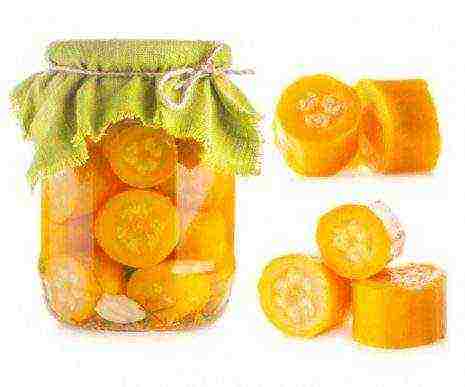
Unusual varieties of yellow zucchini
Yellow zucchini is a rather tasty vegetable, which, moreover, is also healthy. In addition, in order to know the names of the varieties and what they are, it is necessary to clarify that both zucchini and yellow-fruited zucchini are bush varieties of common pumpkin, only without lashes and with oblong fruits. What are the unusual varieties of this vegetable?
Variety "Banana"

The variety is not very similar to the familiar bananas. In appearance, these are ordinary zucchini, which grow about 35 cm. Some vegetable growers say that fruits are formed, as well as bananas, in bunches, while others, that the pulp is very sweet and crunchy, it is fried and stewed in record time. Young mothers can feed their babies with mashed potatoes from such zucchini without fear, and the little ones will not have either diathesis or allergies.
From the moment of germination to fruiting, it usually takes 50 days. Zucchini is picky. As a rule, if the fruits are left for a long time, they will lose their juiciness. The main advantage of the variety is the survival rate of seedlings and quite normal seed germination. But it should be alerted to the fact that such zucchini are unstable to powdery mildew.
Variety "Orange"
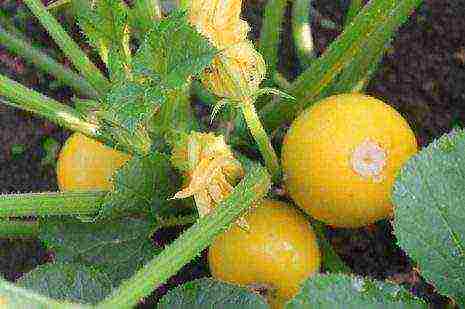
In all the variety of vegetables that have a golden color, zucchini stands out «Orange», which has won great sympathy among those who prefer yellow vegetables. Its shape and color are rather unusual and really look like an orange. Zucchini can be stuffed, as their diameter is about 17 cm.The variety is quite early, ripe fruits can be harvested only 40 days after the first pair of leaves appears on the bush.
Pear-shaped variety
This variety is early. It enjoys the sympathy of gardeners due to the fact that it has an unusual fruit shape - like for squash. And the color of the fragrant pulp is similar to a pumpkin. It should be noted that such a vegetable is very well stored.
Spaghetti variety
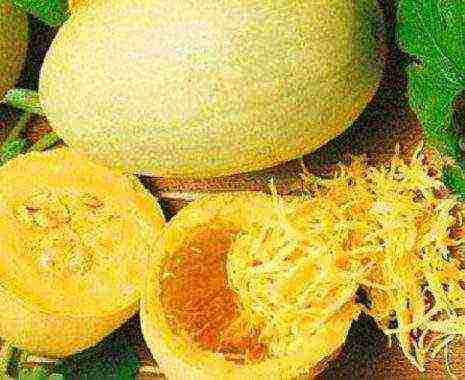
It turns out that it would be no joke to say that spaghetti is growing in the garden. Indeed, there is a variety of zucchini - "Spaghetti": "Spaghetti raviolo", "Caruso" and several others, which were combined into a spaghetti group. They are short-fruited, oval in shape, cream or light green in color. If the fruit is not ripe, then it is impossible to see any original properties, but mature, and even prepared in a special way, will turn into a heap of juicy fibers that are visually similar to a plate of pasta.
Variety "Pineapple"
Harvesting squash "Pineapple" - this is also one of the early ripening options for this vegetable. Fruits are cylindrical, slightly elongated, growing for about 40-45 days. They are dark yellow with orange tints, their average weight is 600-800 g. The pulp is strong and juicy, and the crust is soft and tender.
Zucchini variety "Zephyr"
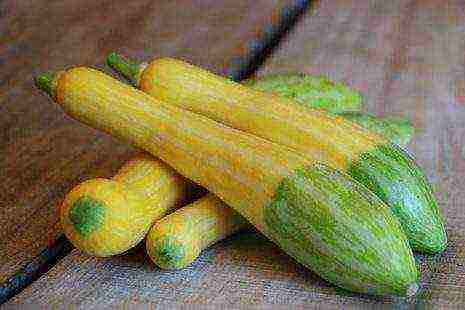
This variety is unlike any other variety of this vegetable. It connects two colors: one half is yellow and the other is greenish. It is considered delicious, its taste is sweetish and very delicate.
Variety "Golden scallop"
A zucchini with a fabulous name "Golden scallop" can boast of the same non-standard and rather interesting appearance. The fruit is bright yellow. On the surface of its tubercles, similar to the comb of a rooster (hence the name). Ripening is mid-season, in order to get the first harvest, you need to wait a couple of months. The fruits are large from about one and a half to two kilograms each. Zucchini yield is quite good. To feel its taste, which has a nutty hue, you should pick the fruits of "milk" ripeness, at the age of about seven days. Like the rest of the zucchini, this variety must be well loosened, fed and watered in a timely manner.
Now yellow zucchini are no longer a rarity. Gardeners dedicated to cultivating these particular vegetables boast a harvest of sunny-toned fruits. Perhaps it will be enough to grow a yellow-fruited zucchini only once in order to forever remain a fan of its good taste and understand how beautiful the dishes that are prepared with his direct participation look like.
It's hard to imagine a vegetable garden without a vegetable marrow. This vegetable is one of the first to be harvested and appears on tables in the form of various dishes. The ease of growing zucchini, availability, early maturity and other characteristics allow, with proper care, to grow these plants of various varieties in open ground, greenhouses and greenhouses in Siberia, Moscow region and in the Leningrad region.
Varietal variety of zucchini
Our grandmothers did not think much about the varietal characteristics of the plants grown and from year to year they collected their seeds from the best fruits. Sometimes a new variety appeared on the site, but its main characteristic was color spectrum fruits: white, green, yellow, etc. with
The arsenal of modern gardeners is much wider and the color scale as a sign has faded into the background. Attention is paid to such characteristics as:
- Ripening terms (early, middle, late);
- Growth type (bush, climbing);
- Pollination features (parthenocarpic or insect pollinated);
- Productivity.
These and other characteristics allow the rule to select a species for specific conditions and get the most out of each plant.
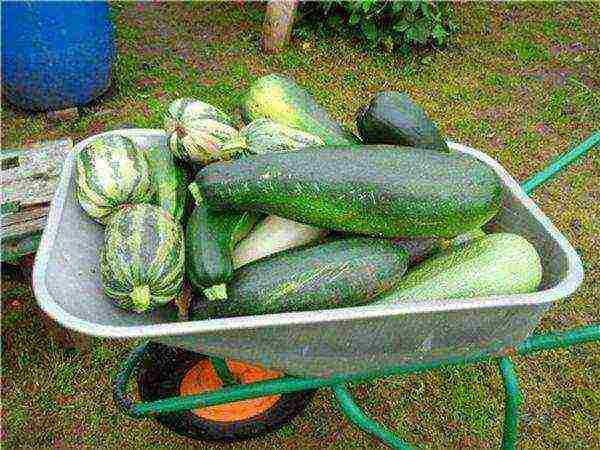 To get a good harvest, you need to select a variety according to its characteristics.
To get a good harvest, you need to select a variety according to its characteristics.
Among the variety of zucchini, special attention should be paid to varieties that have earned the recognition of breeders and are most popular with gardeners. Each group has its own favorites.Someone is convenient due to their ripening time, and someone conquers with their compactness.
The best varieties of bush type for growing outdoors
Most asthenia of the Pumpkin family form long, spreading whipsthat require large areas. At the same time, modern summer residents and gardeners are often limited to 6 acres, on which they want to plant a variety of crops.
The limited space and savings of every meter make planting traditional climbing varieties a real luxury, but bushy ones become a godsend for such sites.
Bush squash you can easy to fit into tight spaces and even plant in a flowerbed among flowers, where large leaves will be an excellent backdrop for other plants.
Aeronaut
Compact plant. Shows good disease resistance.
Fruits are green, 14-15 cm long, tasty, versatile. They perfectly withstand transportation. Subject to the rules of agricultural technology from 1 sq. m of area can be collected 7-7.5 kg.
 Aeronaut
Aeronaut
White
Ultra-ripe... The first fruits are ready to be harvested within 35-40 days. Fruits of white color, oval, excellent taste, universal purpose The pulp is dense, creamy. Stores well.
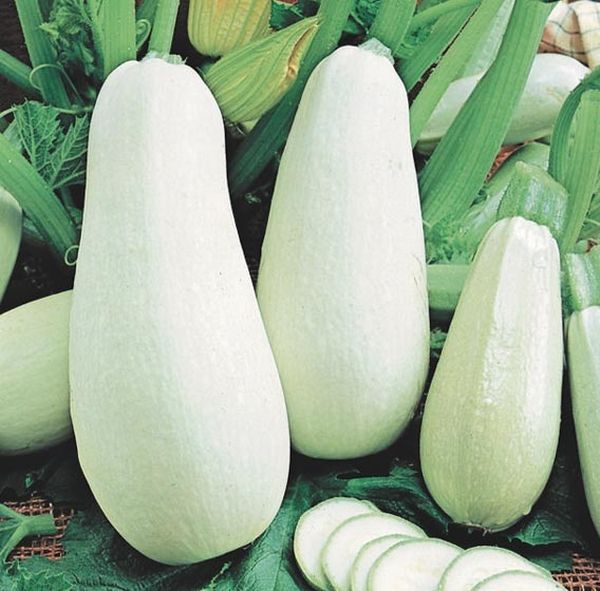 White
White
Waterfall
Early ripe hybrid. Fruits weighing up to 500 g, green. The pulp is dense, white. The yield is high. Disease resistance is above average.
Odessa
Early maturing bush type variety. Disease resistance is very high. The fruits are pale green, cylindrical. The pulp is pinkish yellow or light yellow. Suitable for canning.
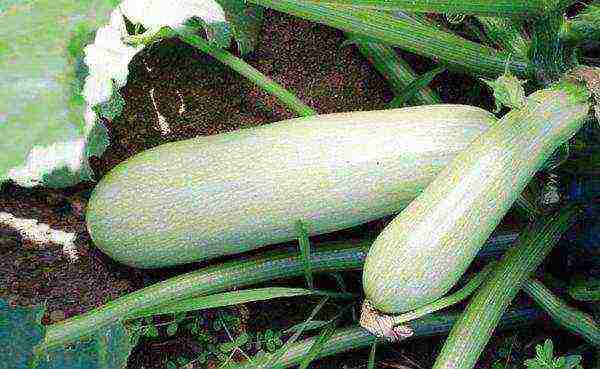 Odessa
Odessa
Best self-pollinated parthenocarpic species
Zucchini forms female and male flowers. In most cases, pollination and fruit setting occurs with the help of insectsthat carry pollen. However, when grown in greenhouses, especially in winter, cross-pollination is problematic.
Parthenocarpic varieties that are able to set fruits without pollination are becoming a real find. These varieties are also great for open ground.
Kavili
Early ripening and high yields make the Cavili hybrid one of the best.
Fruits are light green, up to 22 cm long. Fruiting is abundant and long-lasting. The ripening period is 1.5 months, and the active setting of new fruits takes place within 2 months in any conditions, even without any participation of pollinating insects. During this time, from 1 sq. m manage to collect about 9 kg... The pulp is tender, juicy, whitish.
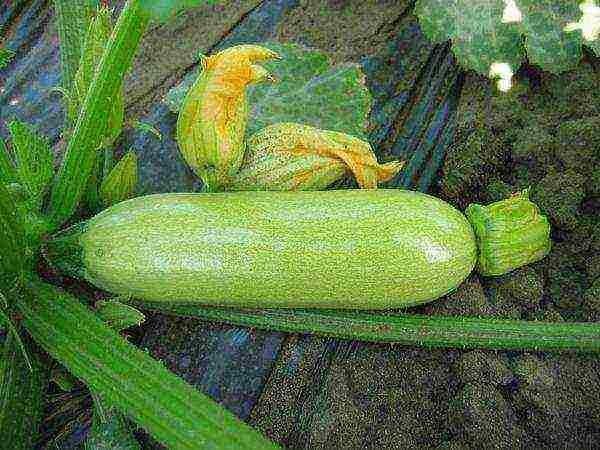 Kavili
Kavili
Jellyfish
Super early hybrid. Ideal for early production under cover films. Withstands large temperature changes.
Ripening period 35 days. The fruits are light green with a delicate skin. The pulp is dense, the seed chamber is miniature. Fruit weight can reach 800 g, with a length of 25 cm.
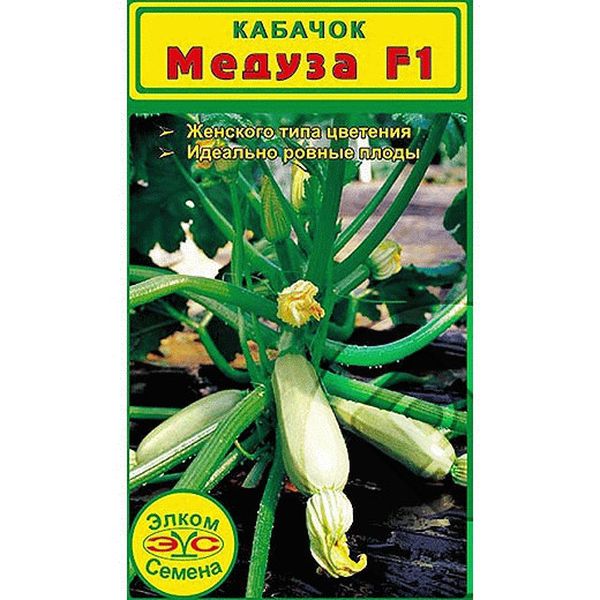 Jellyfish
Jellyfish
Parthenon
A Dutch breeding hybrid, very compact and productive. For 1 sq. m you can place 3-4 bushes and collect up to 15 kg fruits. Good insect-free fruit set and early ripening make this variety an excellent candidate for greenhouse planting.
The fruits of the variety are dark green, cylindrical with light green dense, juicy and tasty pulp. It can be used not only for canning and preparing various dishes, but also eaten raw. Zucchini fruiting period very long and can stretch until September.
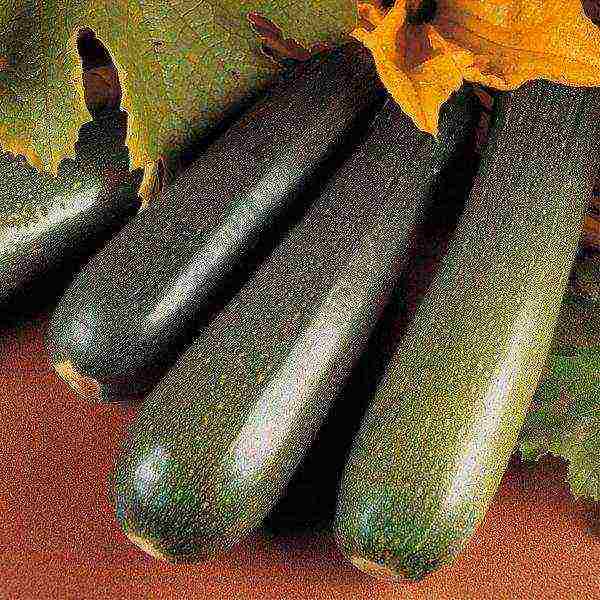 Parthenon
Parthenon
Early varieties
Zucchini varieties of early ripening are of particular value, because it is they who most often become the first fresh vegetables of the new summer season.
Iskander
An early ripe parthenocarpic hybrid bred by Dutch breeders. Ripening period 40-45 days.
The special value of the variety lies in its ability to set fruits at low temperatures, which is especially important for northern regions with cool summers.
When planting 4 plants per 1 sq. m yield is 15 Kg... Iskander fruits are light green, up to 20 cm long, with a thin delicate skin. The pulp is tender, juicy, creamy or white.
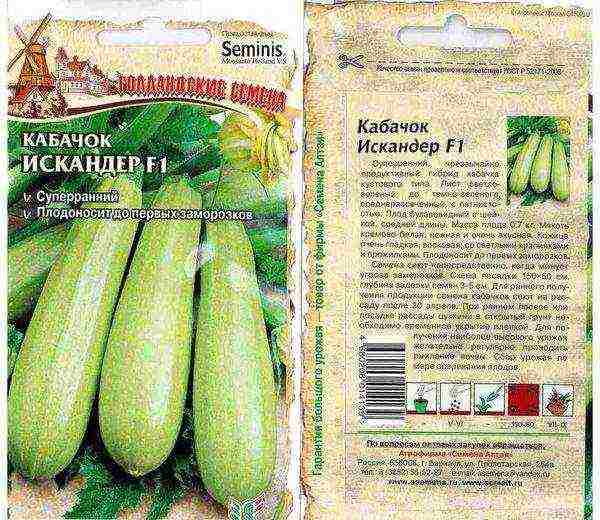 Iskander
Iskander
Tsukesha
The ripening period of the Tsukesha variety is 41-50 days. The plant is characterized by large dark green leaves with gray spots. These are varietal features of color and should not be confused with a disease.
Fruits up to 40 cm long and weighing up to 900 g. Fruiting continues until frost. Fruit well stored and transported... The pulp is juicy, very tasty.
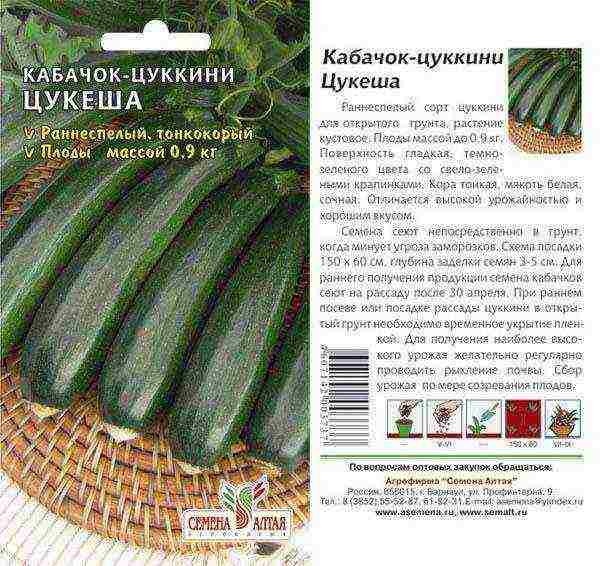 Tsukesha
Tsukesha
Ball
The main feature of the variety is green globular fruit covered with light dots that look like a ball. The pulp tastes excellent.
Ripening period for round squash is 50-55 days. The plant is compact, bushy with strongly dissected leaves.
 Ball
Ball
Aeronaut
This variety has already been mentioned as a popular bush squash, but the early ripening period is another plus in the piggy bank of positive characteristics. Ripening period 42-45 days.
Medium ripening
Gribovsky
The widely known white-fruited variety Gribovsky. Ripening period is not less than 46 days, depending on the region of cultivation. Plant forms long lashes.
Fruits up to 20 cm in size, white. The skin is hard, the flesh is tasty, white or yellowish. Yield 8.5KG from 1 sq. m.
 Gribovsky
Gribovsky
Zolotinka
Ripening period 50 days. Bush type of growth. The color of the fruit is fully consistent with the name.
 Zolotinka
Zolotinka
Black handsome
Bush grade. Ripens in 45 days. Fruits are very dark green in color, close to black. The peel is thin, the flesh is greenish, with a delicate taste.
The fruits are versatile and suitable for all possible uses. At the same time, 4-5 fruits can be tied on a bush.
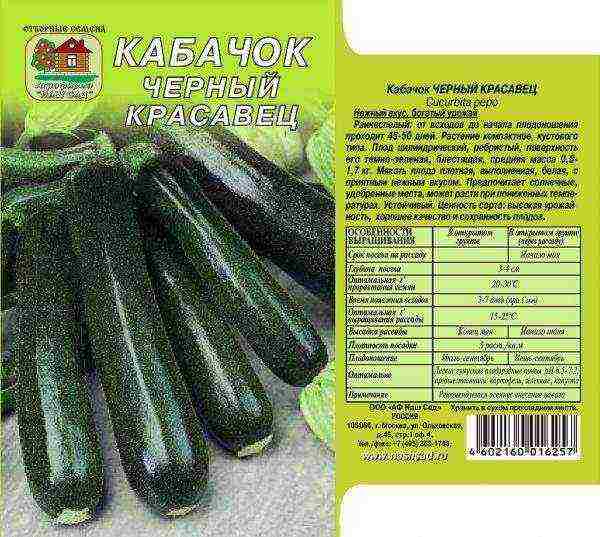 Black handsome
Black handsome
Late zucchini
Spaghetti
An unusual variety that is only gaining popularity.
Young zucchini Spaghetti tastes no different from the usual varieties, but after full ripening, the flesh of the zucchini stratifies into fibers and a peculiar kind is obtained. vegetable spaghettiwhich has many fans. Outwardly, ripe fruits resemble small melons in shape and color.
The only problem - late ripening, which in regions with a short summer does not always allow waiting for "macaroni".
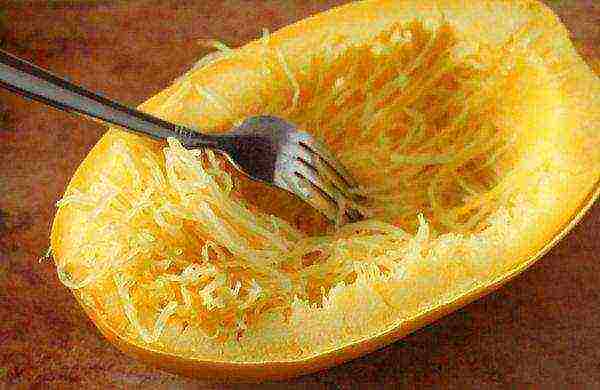 Spaghetti
Spaghetti
Lagenaria (Calabaza)
This type of pumpkin is also called Vietnamese zucchini... Due to the long ripening period and exoticism, lagenaria cannot be called a frequent visitor to vegetable gardens. The shape of the fruit varies.
When young, they are used as food in the same way as pumpkin or vegetable marrow. In a ripe state, the walls and pulp dry out and a cavity forms inside.
Traditionally, this plant was used by some peoples for the manufacture of vessels.
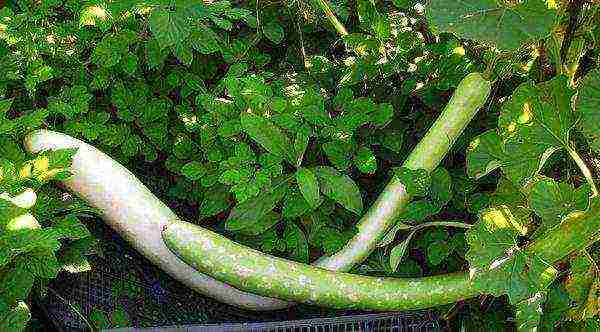 Lagenaria
Lagenaria
The variety of zucchini allows you to choose the right variety not only for certain growing conditions, but also for aesthetic and taste reasons.
With the right combination of hybrids, you can get a good harvest even from a small area and extend the fruiting period. And some exotic varieties can help diversify traditional culinary dishes and grow craft materials.
Zucchini varieties: description, photos, reviews
Zucchini is a low-calorie dietary product with a rich vitamin and mineral complex, very useful for the prevention and treatment of excess weight, liver and kidney diseases, cardiovascular diseases.
Zucchini Iskander
Early maturing (period from germination to technical maturity 40-45 days), high-yielding, Dutch marrow hybrid. Ties fruits even at low temperatures. The plant is bushy, compact. The leaf is light green to dark green, moderately dissected, with mottling.
Fruits are cylindrical with a narrowing towards the peduncle, medium length (18-20 cm), light green with white spot. The average weight of zucchini is 500-700 g. The pulp is firm, tender, creamy white, very tasty. These zucchini are suitable for dining and canning purposes.
Important: the fruits, when outgrowing, do not lose their delicate taste.
The hybrid is resistant to powdery mildew and anthracose.
Iskander zucchini seeds are processed with thiram, they do not require soaking.
Recommended planting pattern: 150-200 x 60-70 cm.
Productivity of Iskander zucchini high.
Zucchini Cavili
Ultra-early, parthenocarpic, high-yielding Dutch zucchini hybrid with a long fruiting period (more than 2 months). From germination to the first harvest of fruits, 40-42 days pass. Bush plant with short internodes.
Fruits are cylindrical, very straight, light green with white flesh, 16-22 cm long, with a delicate taste. The average fruit weight is 300-500 g. These zucchini have a universal purpose - for home cooking and canning processing.
Under stressful conditions (rainy weather, heat, absence of insects), Kavili F1 forms fruits without pollination.
Hybrid advantages: parthenocarp, high productivity, marketability of fruits, duration of fruiting, resistance to powdery mildew.
Yield of Kavili zucchini: 7 - 9 kg per sq. m.
Recommended planting pattern: 140 x 70 cm. The seeds are treated with thiram, do not require soaking.
Zucchini Black handsome
Medium early (45-55 days pass from germination to the beginning of fruiting), a variety of foreign selection. The plant is bushy, compact, strongly leafy. 3-5 fruits are tied on the bush at the same time.
Fruits are cylindrical, smooth, glossy, thin-crusty, dark green, almost black, 18-22 cm long, weighing 0.5-1 kg. The pulp is greenish-white, dense, tender, savory. These zucchini are good for cooking and preserving.
Zucchini yield Black handsome: 14-20 kg from 1 sq.m.
Advantages of the variety: resistance to the main diseases of zucchini, long-term fruiting, high yield and marketable quality of fruits.
Recommended landing pattern: 60 x 60 cm.
Zucchini Aral
An early ripening (only 30 days from germination to the first harvest) hybrid of a vegetable marrow. The plant is of medium vigor, semi-leafy, with medium internodes.
Fruits are cylindrical, slightly ribbed, light green with sparse whitish spots. Zucchini length 12-15 cm, diameter 4-6 cm, average weight 500-800 g. The pulp is firm, tender, with excellent taste. The fruits are used boiled, stewed and fried, as well as fresh (young ovaries) in salads. These zucchini are also tasty when preserved.
Ripe large fruits are well stored, they retain their qualities for up to 4 months.
Aral F1 hybrid is resistant to the main diseases of zucchini.
It is recommended to plant in the ground according to the scheme: 60 × 60 cm.
Yield of zucchini Aral: up to 10 kg from 1 sq. m.
Zucchini the most
Early maturing (the period from germination to the first harvest of fruits 38-45 days), a productive hybrid of a vegetable marrow for growing in open ground and film shelters. The most hybrid F1 shows excellent results in all climatic zones of Russia.
Bush plant with medium internodes.
Fruits are cylindrical, 25-30 cm long, 5-8 cm in diameter, with an average weight of 600-800 g, orange in color. The pulp is yellow-orange, tender, juicy, of excellent taste. These zucchini are good for home cooking and canning.
Zucchini yield The most: up to 7 kg from 1 sq. m.
Advantages of the hybrid: original fruit color combined with excellent taste of tender pulp, good yield, short ripening times.
Tsukesha Zucchini
Early (41-50 days from germination to the beginning of harvesting), high-yielding variety of marrows for open and protected ground. The plant is bushy, compact.
Fruits are cylindrical, with a thin skin, green with light green specks. The average weight of a vegetable marrow is 700-900 g. The pulp is white, crispy, of excellent taste. Thanks to their high solids content, these squash are good for pickling, pickling and all types of home cooking.
Tsukesha is one of the highest-yielding varieties of zucchini, which yields 11-12 kg of fruit per plant per season.
Advantages of the variety: early maturity, excellent yield, compactness of the bush, suitability of fruits for storage.
Yield of zucchini Tsukesh: 6-12 kg from 1 sq. m.
It is recommended to plant according to the scheme: 70 x 70 cm.
White marrow
Early ripening (from germination to fruiting 36-41 days) variety of white-fruited zucchini of domestic selection. The plant is bushy, compact, single-leafed.
Fruits are cylindrical, smooth, with a slight escape to the stalk, weighing 600-900 g, with a thin white skin. Zucchini pulp is white or light creamy, medium density, tender, excellent taste.
These white-fruited zucchini have good keeping quality and transportability.
Productivity of zucchini variety Beloplodny: up to 10 kg from 1 sq. m.
The variety is resistant to bacteriosis.
Zucchini Kid
Early maturing (the period from germination to the beginning of harvesting 38-47 days), a productive variety of white-fruited zucchini with a friendly return of the harvest. Bush plant.
Fruits are cylindrical, smooth, with a creamy white skin, up to 20 cm long, weighing 0.6-1 kg. The flesh of the squash is white, dense, of excellent taste. These zucchini are recommended for baby and dietetic food, they are also tasty when preserved.
Zucchini yield Kid: 9-10 kg from 1 sq. m.
Zucchini variety Malysh is warm and photophilous, easily affected by frosts.
Zucchini Roller
Ultra-early ripening (from germination to the beginning of fruiting 35-38 days), high-yielding zucchini variety. Bush plant, standard, 25-35 cm high.
Fruits are oval, smooth, light green (mesh and pattern are absent), weighing 0.9-1.3 kg. The pulp is light green, loose, tender, with good taste. These zucchini have good keeping quality and transportability. Perfect for fresh consumption and canning.
Recommended planting pattern: 70 x 70 cm.
Zucchini yield Roller: 7-9 kg from 1 sq. m.
Advantages of the variety:high yield, excellent taste, resistance to low temperatures. The Rolik variety responds well to the application of organic fertilizers.
Zucchini Orange
An early ripening variety of zucchini with an exotic appearance. The period from germination to collection of the first fruits is 40 days. The bush is compact, with numerous bright, round fruits. Zucchini should be picked in time when their diameter does not exceed 15 cm. The pulp in this case (in immature ones) is sweetish, especially tasty when raw!
Zucchini grade Orange, video
Zucchini Aeronaut
Early ripe (from germination to technical ripeness 40-46 days), one of the most popular varieties of zucchini marrow. Predominantly female flowering type. The plant is bushy, there are few lashes, the main shoot is short.
Fruits are cylindrical, dark green with light green dots, weighing 1-1.5 kg and 14-15 cm long. The skin is thin. The pulp is whitish-yellow, thick, juicy, slightly sweet. They have good keeping quality and transportability. These zucchini have a universal purpose - they are also suitable for home cooking and canning. At the same time, they are very tasty.
Recommended planting pattern: 40 × 50 cm.
Zucchini yield Aeronaut: up to 7 kg from 1 sq. m.
Zucchini Skvorushka
Early ripe (45-50 days from germination to the first harvest) zucchini variety. The plant is bushy, compact, with a large number of female flowers.
The fruit is cylindrical, slightly ribbed, dark green with faint white specks, weighing 0.5-1.1 kg and 20-25 cm long. The flesh is white or light yellow, dense, juicy, tender and very tasty. These zucchini are suitable for home cooking, preservation and processing.
Advantages of the variety: high productivity, drought and cold resistance, excellent taste of fruits, good transportability.
Recommended planting pattern: 150 x 60 cm.
Productivity of squash Skvorushka: 8-10 kg from 1 sq. m.
We recommend purchasing excellent quality zucchini seeds in the Sady Rossii online store.
Agrotechnics for growing zucchini
Light, fertile, low groundwater soils are most suitable for zucchini; it does not tolerate acidic soils. The best predecessors for squash are onions, root vegetables, tomatoes, potatoes.
Before planting, the site is dug up and fertilized with organic and mineral fertilizers, as well as ash, if necessary, lime.
Sowing seeds is carried out in late May-early June after the threat of return frosts has passed. Seeds are sown in holes, 2-3 pcs. The distance between the holes should be at least 60 cm. After emergence, the weak plants are carefully removed or cut.
All subsequent care for zucchini consists in regular watering, loosening, hilling and feeding.
Harvesting of fruits is carried out regularly at intervals of 2-3 days, preventing them from overripening.
Zucchini can also be grown via seedlings. Seedlings are sown in early May, and in open ground, seedlings are planted in early June, in the phase of 2-4 leaves.
Reviews of zucchini varieties
If you grow zucchini and some of these varieties are not described here, please write the name and give at least a brief description of it. What do you like about this variety, what kind of zucchini yield is obtained in your climate? If possible, attach photos of the zucchini grown by you Thank you!
Your reviews and additions will help many gardeners choose the best varieties of zucchini for planting.
Be sure to include the region where your site is located. So readers will find out which varieties are more suitable, for example, for the Moscow region, the north-west, Siberia and the Urals and other climatic zones.
